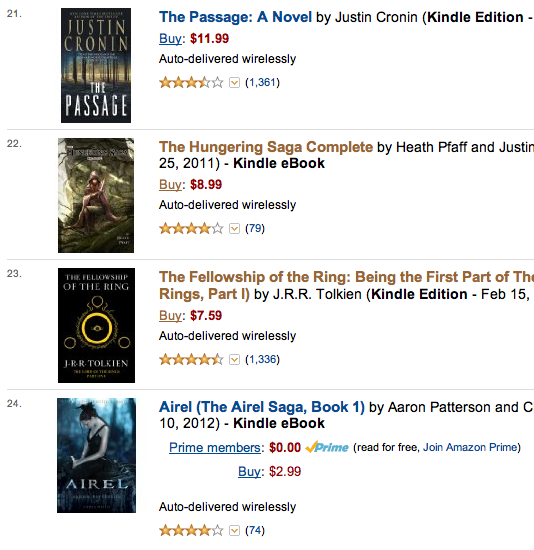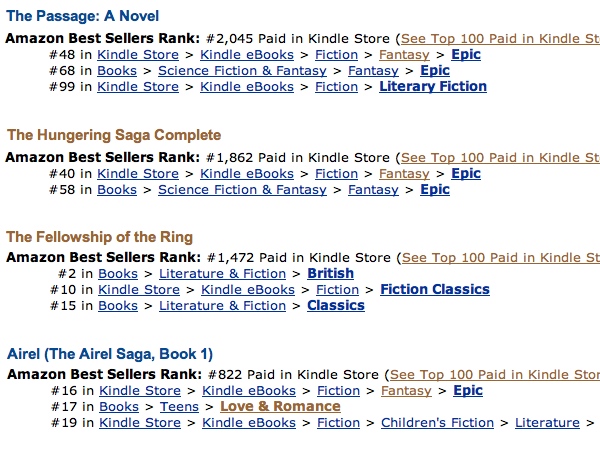I’ve made a small edit to my first post on Amazon’s recent changes to their sales algorithms. As you’ll recall, in that post, I took a look at the three different sets of popularity lists Amazon was displaying between March 19 and May 3. To summarize, List A was Select- and indie author-friendly. List B showed signs that making your book free would be drastically less effective than it used to be. And List C looked downright draconian: even strongly-selling indie books that had never been free were ranked 15-25% worse on List C than on List B.
Originally, we thought this was because List C factored physical book copies into its ranks, inadvertently penalizing indies who predominantly sell ebooks. We were wrong. The difference appears to be about price.
I first started looking into this after Phoenix Sullivan noticed there were very few $0.99 books high on the popularity lists. (The popularity lists are the main browsable lists displayed on Amazon. For instance, the Epic Fantasy list can be seen here.) It was theorized that the new algorithms were discriminating against the $0.99 price setting, weighing $0.99 sales at a lesser value than at higher price points. I wasn’t entirely comfortable with this theory, because I generally don’t think Amazon sets their algorithms with specific goals in mind (besides “Make $, win”). So I compared hundreds of books on several different popularity lists, focusing on the lowest-priced ebook titles. Soon, I was honing in on the highest-priced books, too. Because I was seeing something very, very strange.
The higher the price, the better the book was placed on the popularity lists.
In other words, say you’ve got a $0.99 book at #10 on the Epic Fantasy list. (Popularity list, not bestseller.) Say its sales rank (bestseller list) is #1000. The books at #9 and #11, meanwhile, are both listed at $9.99–and their sales ranks will probably look more like #3000, say.
This isn’t an ironclad correlation. Bestseller rank is a transitory thing. It shifts very quickly compared to popularity rank; a book that’s #1000 today could be #1 or #10,000 tomorrow. Seeing one instance of a book outperforming its bestseller rank on the pop list ranks proves nothing.
Seeing hundreds of these instances, however, is another thing altogether.
And that’s what I saw. Repeatedly. Undeniably. It was 1 AM, I’d had a couple of drinks, and my fiancee was snoring on the couch as I nerded it up with my numbers, but what I was seeing was strong enough to not only prove the theory I’d set out to disprove, but to go one step further: all things being even in terms of sales, not only did a lower price indicate a worse position on the popularity lists, but a higher price indicated a better one.
The implications for indie authors are immediate. And not pleasant. Most indie authors price their ebooks between $0.99 – $5.99. A few brave souls and small presses price as high as $9.99, but generally speaking, $5 and under is seen as the way to reach readers who may be hesitant to take a shot on a lesser-known or completely anonymous author. But if you price at $2.99 while HarperCollins prices at $12.99, you’re going to have to sell significantly more copies to be neighbors on the popularity lists. And if you’re selling at $0.99, you’re going to have to sell very, very well to achieve the same level of visibility.
We’ve termed this change “price biasing.” Here’s what it looks like in practice. Let me show you a shot of the Epic Fantasy popularity list:
 |
| Evidence of price biasing: Epic Fantasy popularity list, page 2 |
Now, here is the bestseller rank of these same titles:
 |
| Bestseller ranks of these same books |
Let’s move to the next page:
 |
| Epic Fantasy popularity list, page 3 |
And their bestseller ranks:
 |
| Bestseller ranks of these same books |
Take a look at that–in the first example, all of the higher-priced books shown are ranked above the lower-priced books on the popularity list, but their sales ranks are worse. In order! In the second example, the $0.99 book requires drastically higher sales to keep pace on the popularity lists with the $13.99 book. For another example of price biasing, simply go to the top of Epic Fantasy, where George R.R. Martin’s A Game of Thrones 4-Book Bundle, is priced at $29.99 with a bestseller rank of #60 and a popularity list rank of #1. The next book, Martin’s A Game of Thrones, is priced at $8.99, yet is #2–behind the omnibus–despite a bestseller rank of #27.
There are a lot of variables at play here. Because of the volatility of bestseller rank, I can’t be certain that the higher-priced books haven’t outsold the lower-priced ones over the last 30 days, and it will be easy enough to find counter-evidence where books are “properly” ranked and price seems to make no difference. But I’ve tried to minimize the variables by choosing books that haven’t been recently released (so sales should be steadier) and by going to page 2 and 3 of the popularity list, where the volatility should be lesser than at the very top. Really, it wasn’t hard to find this example. Because it’s all over the place. And if you look at hundreds and hundreds of titles next to each other on the popularity lists–especially the extremes, $0.99 – $2.99 books next to $12.99 – $29.99 books–the correlation is extremely high.
I don’t have the answers to a lot of the inevitable questions. I don’t know what the “ideal price” would be to take advantage of this new formula. I don’t know how many more copies you need to sell at $0.99 to achieve the same weight as you would selling at $9.99. I don’t know why Amazon did this, particularly when they price their own imprints at $7.99 and under. I don’t know if this is the end of the world or a brief couple weeks of suffering followed by another golden age.
And let’s not storm the gates or raise all our titles to $199.99 just yet. The popularity lists are far from the only driver of sales through Amazon. There are bestseller lists. Targeted emails. Bargain book lists of all shapes and sizes which you’ll only make through pricing lower. And if you raise your prices significantly enough to achieve a major change on the new popularity lists, you may drive away so many sales your placement actually winds up going down. Unless you’re priced at $0.99, I don’t think raising your price by a dollar or two will make any real difference to your placement on the popularity lists, so please don’t overreact–if you’re still selling, you’re still selling, no matter how the new algorithms may work.
Still, I don’t see how these new lists are any good for indies under any circumstances. What they do is force us to sell more books to maintain the same visibility as higher-priced trad titles. They diminish our ability to experiment with lower prices, whether the goal is a temporary sale, a low-priced entrypoint to a series, or because you just don’t feel comfortable charging more than $0.99 for that 5000-word story.
Furthermore, the playing field is no longer level. Indie authors published through KDP only earn 70% royalties at prices between $2.99 and $9.99. Yet many traditionally published books that are most benefiting from price biasing are priced at $12.99 – $14.99, with some omnibus editions priced as high as $22.99 – $29.99. If indies want to match those prices to match their visibility on the popularity lists, they’ll actually make less money with each sale than they would at $9.99. There’s no way to win.
I don’t like fearmongering. But I don’t see how it helps to sit on this information any longer. I encourage you to look at the popularity lists for yourself. Maybe I’m wrong. I’d prefer if I were. I’ll try to answer any questions in comments, but be prepared for a lot of “I don’t know.” All I know for sure is that if this analysis is correct, the deck has been stacked against us. I highly doubt it was intentional. Indies aren’t being targeted. We’re just a small part of the Amazon equation, and as Amazon attempts to maximize their revenues, I really don’t think they care who that revenue’s coming from. And remember: this is just one factor among many, many others as to how a book is seen on Amazon’s storefront. It’s not a revolution in and of itself.
But it does feel like it will have some impact on indie authors. I thought it was time to share and let everyone experiment for themselves.








Leave a Reply